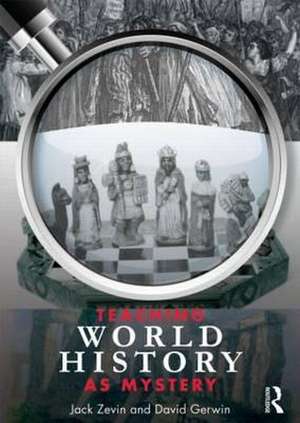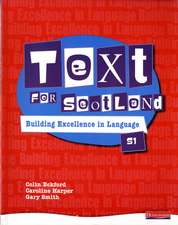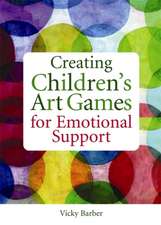Teaching World History as Mystery
Autor David Gerwin, Jack Zevinen Limba Engleză Paperback – 14 oct 2009
Offering a philosophy, methodology, and examples for history instruction that are active, imaginative, and provocative, this text presents a fully developed pedagogy based on problem-solving methods that promote reasoning and judgment and restore a sense of imagination and participation to classroom learning. It is designed to draw readers into the detective process that characterizes the work of professional historians and social scientists sharing raw data, defining terms, building interpretations, and testing competing theories. An inquiry framework drives both the pedagogy and the choice of historical materials, with selections favoring the unsolved, controversial, and fragmented rather than the neatly wrapped up analysis of past events.
Teaching World History as Mystery:
- Provides a balanced combination of interestingly arranged historical content, and clearly explained instructional strategies
- Features case studies of commonly and not so commonly taught topics within a typical world/global history curriculum using combinations of primary and secondary documents
- Discusses ways of dealing with ethical and moral issues in world history classrooms, drawing students into persisting questions of historical truth, bias, and judgment
| Toate formatele și edițiile | Preț | Express |
|---|---|---|
| Paperback (1) | 388.85 lei 43-57 zile | |
| Routledge – 14 oct 2009 | 388.85 lei 43-57 zile | |
| Hardback (1) | 1170.92 lei 43-57 zile | |
| Taylor & Francis – dec 2010 | 1170.92 lei 43-57 zile |
Preț: 388.85 lei
Nou
74.41€ • 77.88$ • 61.93£
Carte tipărită la comandă
Livrare economică 31 martie-14 aprilie
Specificații
ISBN-10: 0415992257
Pagini: 256
Ilustrații: 1 black & white tables
Dimensiuni: 175 x 254 x 20 mm
Greutate: 0.44 kg
Ediția:New.
Editura: Routledge
Cuprins
Introduction: Why teach history as mystery?
Chapter One
Constructing and teaching
The concept of teaching history as mystery defined and explained
Mysteries in the Classroom
Chapter Two: Grasping the world
Looking at the World Anew:
World Historians’ thinking and rethinking of global history
Chapter Three: Prehistoric Times (Asia and Europe)
Megaliths & Monoliths in Bronze Age Europe:
The Mystery of Stonehenge and its Cousins Revisited
Chapter Four: Classical Times (Europe, Middle East, and Africa)
Why did the Roman Empire last so long?
An investigation of the Roman system of governance, economics, and military organization, as well as engineering skills
Chapter Five: Medieval/Renaissance Times: A Medieval Rebellion
Wat Tyler’s Rebellion and/or German Peasant Revolt (Europe)
Why do people rebel even when the odds are against them?
Chapter Six: Medieval Times in Europe and the Middle East
Eyewitnesses on the Crusades: Christian, Muslim, and Jewish Views
Perspectives on history, comparisons and contrasts from the Crusades
Chapter Seven: 17th and 18th Centuries
A World of Exploration and Trade (Europe and Africa)
Atlantic Slavery viewed from both sides of the Ocean and from different cultures
Chapter Eight: Multiple Time Zones
Finding Mysteries Everywhere: Spies and counterspies as myth and reality (Europe, Asia, South America)
Comparisons of spies, both romanticized and real, from widely different times and places
Chapter Nine: The New World Invaded (South America and Europe)
The Conquest of Peru, Why did it Fall to So Few?
Developing an interpretation of Inca and Spaniard using contemporary woodcuts
Chapter Ten: The 20th Century
Age of Authority and Rebellion (Global)
Case Study of Heroes and Villains and the Rewriting of History
Changing Views of Great Leaders as Heroes and Villains
Chapter Eleven: Gender Issues
Where are the Women in World History? (Global)
An inquiry into the scarcity of women in world history
Chapter Twelve: Finding Mysteries Everywhere,
Sources, Resources, and Outright Fabrications
A How-to guide for sleuth teachers to use sources to construct their own mysteries for the classroom
Finale: Socratic Conversation
Bibliography and Notes: Resources and References
Resources, Sources, and Websites, etc. and a Bibliography
A Bonus Mystery Game of Sequent Occupation
A Mystery Game of global development, changing the landscape: Transforma
Textul de pe ultima copertă
Teaching World History As Mystery:
- Offers a balanced combination of historical content, interestingly arranged, and instructional strategies, clearly explained
- Provides an integrative view of world history content and research based on recent scholarship
- Delineates a fully developed pedagogy based on inquiry and problem-solving methods that restore a sense of imagination and participation to classroom learning.
- Includes case studies of commonly and not so commonly taught topics within a typical world/global history curriculum using combinations of primary and secondary documents Balances topics among and between time periods, geographic areas, and cross-disciplinary issues and controversies.
- Discusses ways of dealing with ethical and moral issues in the world history classroom, drawing students into persisting questions of historical truth, bias, and judgment.










